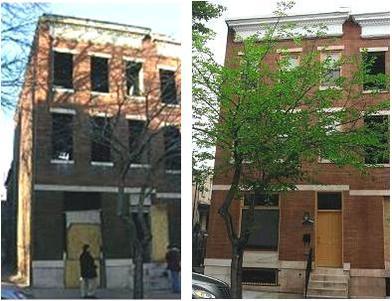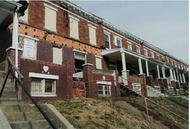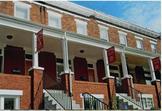|
A Banner Year for Baltimore Historic
Tax Credit Investments
Despite ongoing fluctuations in the real estate market, the
Baltimore City Historic Rehabilitation and Restoration Tax Credit Program
continues to grow -- promoting high quality rehabilitation work throughout
Baltimore’s Historic Neighborhoods. The program has experienced an increase in
applications over the past two years and has seen more completed projects in a
wide variety of historic districts. In fact, the number of applications has nearly doubled
year to year, over the last three years.
In addition, new district designations such as the National
Register designation of the Locust Point Historic District, and an increase in Commission for Historic and Architectural Preservation (CHAP) designations of Baltimore City Landmarks, have made the tax credit available
to a growing number of properties.
 Pictured Above Left: Vacant E. Biddle Street Property BEFORE rehabilitation. Pictured Above Right: The same E. Biddle Street Property AFTER rehabilitation using the Historic Rehabilitation and Restoration Tax Credit.
Since the start of 2013, CHAP has approved 220 new
projects in 29 historic districts, including Butcher’s Hill, Old East
Baltimore, Ednor Gardens, Pigtown, Ten Hills, Union Square, and
Sharp-Leadenhall.
This is a dramatic
increase from 2011, when 127 applications had been approved, and an increase
from 2012 when 205 applications were approved. The majority of the 2013 projects
are single-family residential rehabilitations; however, there are a growing
number of multi-family and commercial applications, including the Baltimore
City Landmarks, the Haven Street Factory in East Baltimore (pending)and the Associated
Black Charities Building in Mount Vernon.
 Pictured Above: A closeup of the rehabilitation work done to a vacant property on the 1500 Block of E. Biddle.
The credit
continues to be a successful tool in revitalizing vacant properties, with the
majority of applications noting that the property is listed as vacant. Many
applicants are taking advantage of other City initiatives along with the tax
credit. This year, there were 19 applications for properties purchased from the
City of Baltimore and 9 purchased through the Vacants-to-Values program.
|
Pictured Right: A series of Rowhomes on Violet Avenue BEFORE being rehabbed.
|
|
 |
 |
|
Pictured Left: Violet Avenue Rowhomes AFTER being rehabbed using the City of Baltimore Historic Rehabilitation and Restoration Tax Credit. |
The number
of completed projects that have been certified for the tax credit are also
high. There were 155 projects certified for the tax credit since January,
leveraging $24,869,486 in investment in historic buildings and neighborhoods. With
this investment, it brings the program total to $589,146,570 since the tax
credit was first offered in 1996.
Most of the completed projects are residential rehabs. A
significant concentration of tax credit activity occurs within the historic
districts of East Baltimore, including
Broadway East/South Clifton Park, Canton, Butcher’s Hill, Patterson
Park/Highlandtown, Fell’s Point, Upper Fell’s Point, Washington Hill, East Monument and Old East
Baltimore.
In the Broadway East/South Clifton Park and East
Monument neighborhoods, the rehabilitation work is primarily on vacant properties, completed by
groups like TRF, Come Home Baltimore, and Habitat for Humanity of the
Chesapeake. These groups have generated a combined investment of $5,648,891, in 33 properties
completed so far in 2013.
The Baltimore City Historic
Rehabilitation and Restoration Tax Credit Program is an important
revitalization tool throughout Baltimore City. As the calculation and
application of the Historic Tax Credit has moved from the State Department of
Assessment and Taxation to the City’s Department of Finance, CHAP has worked
with both agencies to provide accurate data about the projects it has
certified. Although this transition has come with some challenges for the City
and residents alike, some of the upcoming initiatives will provide an
opportunity to address these challenges in a meaningful way.
With so much
activity thus far, CHAP looks forward to what the rest of 2013 will bring. We
are excited about several upcoming initiatives:
1)
The
upcoming renewal effort for the Baltimore City Historic Rehabilitation and
Restoration Tax Credit legislation which currently sunsets in February of 2014
2)
The
release of an online tax credit application, thanks to the hard work of our
partners in the Department of Finance
3)
The
designation of new historic districts and landmarks, including the proposed
Brewer’s Hill National Register Historic District
If you are
interested in learning more about any aspect of the Baltimore City Historic
Rehabilitation and Restoration Tax Credit Program, please contact the program
administrator, Stacy Montgomery at stacy.montgomery@baltimorecity.gov.
CIP Spotlight
The Baltimore City
Charter requires that the Planning Commission annually prepare a six-year
Capital Improvement Program (CIP). The first year of each six-year program becomes the capital budget for the
upcoming fiscal year and is the basis for the capital component of the
Ordinance of Estimates, which is adopted by City Council.
The CIP is a very important role of the Planning Department, and
the projects have the potential to transform communities. Each month
The Compass highlights a project from the CIP. This month’s featured project is the Baltimore City
Convention Center’s Roof.

In
August 2010, the Baltimore Convention Center’s Outdoor Terrace officially
became the Green Roof.
The completed
outdoor roof terrace renovations covered 27,497 square feet (SF), of 12,245 SF consists of vegetative roofing and 15,252 SF of hardscape roofing. This included replacement of the existing 1978
terrace roofing membrane system and roof drains, while removing all
existing architectural features of the terrace roof .
The renovations included installation of a new
terrace walkway paver system, new irrigation systems, a new aluminum space
frame canopy structure with a green roof feature at the east end of the terrace,
concrete benches, trash containers, lighting and electrical upgrades. The
unique design of functional space has aesthetic appeal to promote greater patron
use, and has multiple sustainable features, including a vegetative system that
captures rainwater and improvements that have reduced energy use. The Baltimore
Convention Center’s Outdoor Terrace/Green Roof Renovations were completed in July of 2011.
Total Construction Cost: $ 2.384 million.
Baltimore City CIP: General Obligation
(G.O.) Bonds, $ 1.8 million.
General Funds: $ 200,000.
The remaining $ 384,000 comes from Other Funds sources.
|